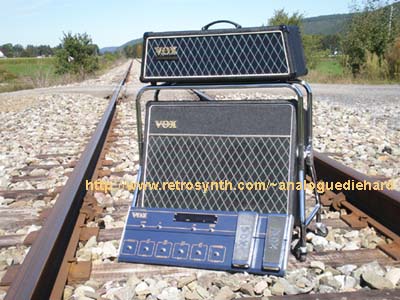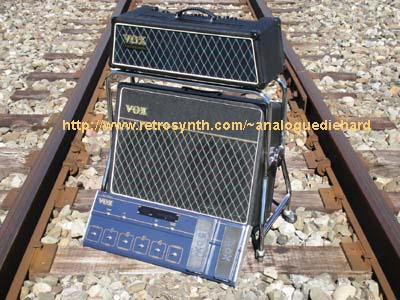Amp
Type
|
Actual
|
|
Pedal
Type
|
Actual
|
|
Mod
Type
|
Actual
|
Vox AC15
|
Vox AC15 vintage, channel 2
|
|
Comp
|
MXR Dyna-Comp
|
|
Chorus
|
Boss CE-2 Chorus Ensemble
|
Vox AC15TB
|
Vox AC15TBX 1990s, 'top boost'
channel
|
|
Acoustic
|
?
|
|
Flanger
|
MXR M117 Flanger
|
Vox AC30
|
Vox AC30 vintage, 'normal'
channel
|
|
Vox Wah
|
Vox V847
|
|
Phaser
|
MXR M101 Phase 90
|
Vox AC30TB
|
Vox AC30 Top Boost vintage, 'top
boost' channel
|
|
Auto Wah
|
?
|
|
Tremolo
|
Fender Twin Reverb tremolo
|
UK Blues
|
Marshall 1960s JTM45, high
treble channel
|
|
U-Vibe
|
Univox Univibe
|
|
Rotary
|
Leslie speaket
|
UK 70s
|
Marshall 1969 "Plexi" 100W, high
treble channel
|
|
Octave
|
?
|
|
|
|
UK 80s
|
Marshall 1983 JCM800 100W
|
|
Treble Boost
|
based on AC30 top boost circuit
|
|
|
|
UK 90s
|
Marshall 1990 JCM900 100W, lead
channel
|
|
Tube OD
|
Ibanez Tubescreamer TS808
|
|
|
|
UK Modern
|
Marshall JCM2000 DSL100 100W,
high gain
channel
|
|
Fat OD
|
Proco Rat
|
|
|
|
Recto
|
Mesa Boogie Dual Rectifier,
modern high
gain channel
|
|
Fuzz
|
Electro-Hamonix Big Muff
|
|
|
|
US Hi Gain
|
Soldano Super Lead Overdrive,
high gain channel
|
|
|
|
|
|
|
Boutique OD
|
Dumble Overdrive Special,
overdrive channel
|
|
|
|
|
|
|
Boutique Clean
|
Dumble Overdrive Special, clean
channel
|
|
|
|
|
|
|
Black 2x12
|
Fender 1960s Twin Reverb
Blackface, clean channel
|
|
|
|
|
|
|
Tweed 1x12
|
Fender 1958 Deluxe tweed "narrow
panel"
|
|
|
|
|
|
|
Tweed 4x10
|
Fender 1959 Bassman tweed
"narrow panel" 4x10
|
|
|
|
|
|
|








